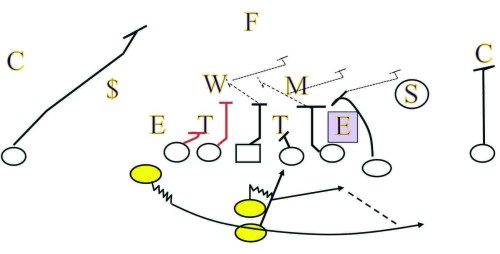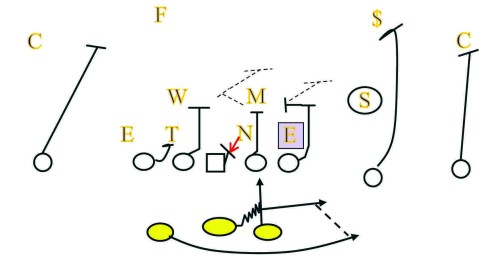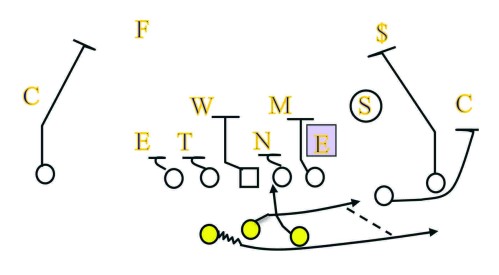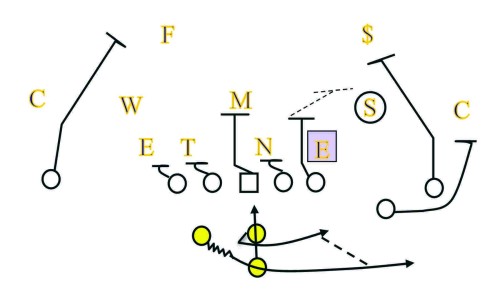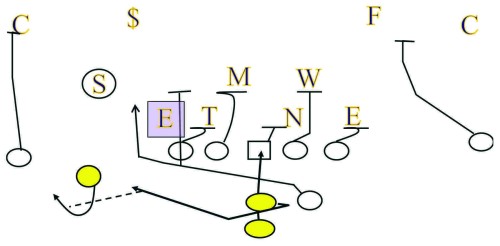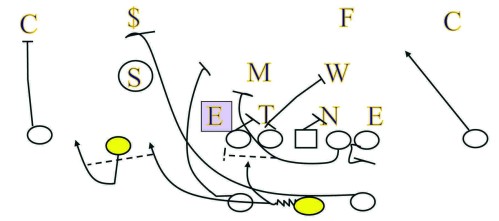Article CategoriesAFM Magazine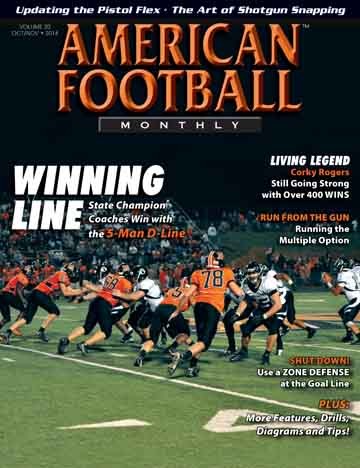
|
Options Galore - To be successful running a multiple option offense from the gun and pistol, every player must identify the read key and the option key.by: Rob CushmanHead Coach, Augustana College (IL) © More from this issue Option football has changed over the years. My experience with the option has included under center wishbone as a high school coach in the mid ‘80s, followed by under center flex-bone as a college coach in the late ‘90s, and flex-bone shotgun in the 2000s. After becoming the head coach at Augustana College in 2011, I wanted to return to option football but with a more updated approach. So, in 2012, we began running a unique, multiple option system from the shotgun and pistol that actually includes 15 different types of option plays. Some are double option. However, the majority are triple option plays. We believe our system requires defenses to play assignment football versus our traditional option but also forces them to defend a variety of formations and non-option plays that actually include an option component. We focus on four different option plays that are staples in our package – the inside veer triple, zone read triple, zone cheat triple, and power read triple. The absolute foundation of our offense is an updated version of the traditional inside veer run from either shotgun or pistol. Although there are skeptics in our profession that don’t believe this play can be effective unless the QB is under center, we have been very successful using it. We always count defensive numbers and look for angles to determine the direction we run. As with all our triple option plays, everyone must identify the read key and the option key.
Diagram 1: Inside Veer Triple (Pistol) Our base approach is to line up in a double slot pistol (Diagram 1) with our QB’s heels at four yards. Our dive back is in the pistol with his toes 1 ½ yards behind the QB’s heels. Our ability to mesh the QB and dive back while attacking the LOS is critical. The QB receives the snap and steps directly down the centerline with his opposite foot and doesn’t step back. This is critical as it allows the mesh to take place closer to the LOS (similar to being under center). While stepping, the QB must get the ball as fast and as deep to the dive back as possible. The dive back is responsible for the timing in the mesh. Because the QB needs time to handle the snap, the dive back must roll and step with his playside foot onto his track while the QB gets his feet and ball in position. Once in the mesh, the dive back then explodes through the LOS. The angle of the dive back is traditional as we aim at the inside hip of the OG, while the QB keeps his eyes on the read key. One difference is because the mesh is at depth, the QB must shuffle into the LOS, riding the dive as long as possible before he gives or pulls. Line splits are important to remove the read key from the mesh as well. We use standard give or pull reads. If the read is “gray”, we give the ball. Generally, we have sent a back into motion to get him in pitch position although we run this from a variety of formations and even drop a WR on the snap and use him as a pitch back. If it is the slot in motion as diagramed, his path is through the toes of the dive back. If the QB keeps the ball, he is a runner until the option key forces him to pitch. This sounds strange but we like our QB to run the C gap if he can, attacking the inside shoulder of the option key while trying to go around him. This gives the QB a cleaner pitch lane as well. The QB makes the option key take the ball out of his hands. The pitch back is responsible to stay in a pitch relationship which is on the QB’s shoulder at four to five yards. At one point in my career we had the QB “run through” the option key. Now, to avoid big hits, we have the QB step, pitch, and bail. We are not softer, just smarter. When we get the ball outside, we are always blocking for outside leverage. If we are in shotgun and the dive back is offset to the side of the QB and ½ yard behind, then the QB opens his playside foot, points at the dive back, and then steps with his opposite foot toward the center to get in position (Diagram 2). The dive back slowly rolls forward, stepping with his inside foot to have a closer mesh with the QB. He then explodes through the LOS. His aiming point is down the crack of the OG. There are a lot of moving parts so we practice both pistol and shotgun (offset) meshes daily for several minutes.
Also, we seldom block the furthest defender outside to the zone side. We try and get our zone runner to think frontside A to backside A or B gap based on the defensive front. The back side of the play almost looks like the inside veer.The QB reads the backside end to give or keep, and we always have a pitch back that comes from somewhere in the formation. We run the play from both pistol and shotgun utilizing a variety of backfields to challenge the defense. Our base approach is using 20 personnel and split backs (Diagram 3).
Diagram 3: Zone Read Triple (2-Back Shotgun) The QB aligns with his toes at four yards, slightly deeper than the inside veer. From split backs, the QB takes a small jab step with his playside foot at an angle to the zone runner with his eyes on the read key. His opposite foot then steps at an angle toward the LOS (similar to inside veer). The RBs align deeper (toes to QB heels) to improve the mesh and their zone running angle. The QB rides and decides to give or keep. Our basic rule, much like the inside veer, is if the read key cancels the zone runner, then the QB pulls the ball. If the QB can beat the end he keeps it. Obviously it helps in this system if your QB can run, although a good decision maker is critical as well. If the QB keeps the ball, the pitch mechanics are just like inside veer, so there is no If we are in a pistol formation with a second RB offset in backfield, we can run the play with the pistol back as the zone runner and the offset back as the pitch back (Diagram 4). We can also switch the zone runner to the offset back (same mechanics as split backs) and the pitch back becomes the pistol back. We run this play from multiple formations and with several types of motion as well.
We also run a very unique play we call the zone cheat triple (Diagram 5). The play is based off of our zone action from the pistol with an offset back becoming a lead blocker for either the zone runner or the QB around the edge. This, in a sense, “cheats” the defense by having a lead blocker for whoever is the ball carrier. Our linemen block their same zone rules so there is no new teaching. The option comes into play as the QB either gives or keeps. If he keeps the ball, he then has the ability to pitch the ball based on the option key just like our other options plays. Again, this phase does not require any new learning. The perimeter blocking is the same as it would be with inside veer to a single receiver side.
Diagram 5: Zone Cheat Triple (2-Back Pistol) We like to run this play in 20 personnel with a pistol back and an offset back set away from our slot. The QB (toes at four yards) punches out with his opposite foot, catching up with his playside foot while facing the read key giving the pistol back the 0 track. The pistol back aligns deeper to allow the ride while giving the offset back time to clear his path. The offset back comes flat across the formation and reads the read key just like the QB. It is important they both see the same thing. If the read key is upfield, this means give, and the back inserts and blocks the first defender to show in the hole. If the read key squeezes and cancels the zone runner, the back wraps around the read key and blocks the first defender outside, usually the scraping LB. He must identify the option key because we don’t want him to block him. If he doesn’t have a scraping LB, he usually can climb to a safety. When in doubt, insert. However, if your QB can run, that thinking may change. The slot becomes the pitch back and drops into a pitch relationship on the snap. This requires timing and feel. We like this slot adjustment because when we don’t add the option component, the slot has to block the overhang which can be difficult. Many spread teams have recently added some form of the power read play. They pull the backside guard across the formation and read the EMLOS. The QB either gives to the RB who runs sweep, or he keeps the ball and runs Q power. Our play is very similar but, once again, we add the option factor. Our base way of running this play is again from 20 personnel with split backs (Diagram 6).
Diagram 6: Power Read Triple (2-Back Shotgun) We set the slot to the front side, but we can run him in motion from the back side as well. The QB puts his toes at four yards but we will slightly deepen him at times for more reading distance. The RBs are at QB depth trying not to give the play away. We like all split back plays to look the same. The QB receives the snap and pauses just slightly to allow the backside (far) back come flat in the mesh. The QB will shuffle two or three times in the mesh with his eyes on the read key. The rule is simple – if he can outrace the read key, then the QB keeps the ball and option the next man outside the read key. If the read key doesn’t give us the edge or is upfield, we run Q power. We pull our backside guard and he reads the end as well. The OG tries to insert inside the end, hug the down block(s) and climbs to a LB. When he inserts, he is blocking for Q power. If the read key squeezes, the OG blocks him on the LOS. We do not want the read key to bounce out to the QB, so when in doubt, we block him. Again, it is important the QB and the OG read it the same way. The front side (near) back takes a flat path to the edge looking for a scraping LB to a safety. The far back, which was involved in the mesh, will never get the ball, and after the fake must race flat around the edge and try and block a safety. The slot once again drops into a pitch relationship on the snap getting into position with the QB. We don’t have to block the overhang (slot defender) because he is the option key. We like this play with a QB who can run both inside and outside with the ball always in his hands. It should be noted that with all the moving parts in all our option plays, defenders show up in unusual places, so our rule is “block anyone in your path other than the read key. The QB will sort it out.” The slot defender and scraping LBs fall into this category. Find more articles like this: Option Football: Few Plays, Many Ways – February, 2014 |
|
| HOME |
MAGAZINE |
SUBSCRIBE | ONLINE COLUMNISTS | COACHING VIDEOS |
Copyright 2025, AmericanFootballMonthly.com
All Rights Reserved


